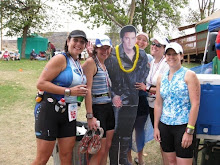Runner's World
I feel like I'm keeping the makers of Advil in business. I'm not injured, but I'm feeling pain and soreness from pushing my body to the limit. Soaking and stretching helps, but is there something else I should be doing? Please don't say REST:) Thanks ~Kim
Hi Kim. I'm glad you wrote as there is a difference between being injured and feeling pain and soreness from the demands of training. They both sit at the threshold, it's just that one is above it (injured) and one is just below. Taking anti-inflammatory products is one way to deal with the pain, another is to modify your training life a bit. Here are a few tips on how you can train hard and recover more efficiently to avoid living in a consistent state of fatigue.
- Run by effort rather than a prescribed pace. If you run by how your body is feeling on the day, versus a specific pace (i.e. (9:45 per mile), you'll train in the right gear on the day, get in a higher quality workout and promote faster recovery. For example, you wake up to run your weekly tempo workout and head out to a strong headwind and humid temperatures. If you run it by your normal tempo pace, you will expend a lot more energy to get in this workout. If you run it by feel and effort, you will get in the tempo at the pace on the day and at the correct effort thereby allowing your body to recover faster because you didn't push too hard.
- Run truly easy on your easy days. One of the easy mistakes to make while training for a event is to get into what I call the La La Pace – where, most runs are done at the same effort which turns out to be too fast for an easy, recovery run and too slow for a speed workout. As you build and progress through the training season, it takes a toll and creates more fatigue, slower recovery times and poor performance. Easy means not being able to hear your breathing while running. Slow it down to recover so you can kick butt on the longer and faster workouts. It just takes patience.
- Mix it up. When I first started coaching running over 18 years ago, there was not one program that included cross-training. The belief was that if you wanted to run longer and faster, you had to invest only in running. My background in the fitness world told me different. First, by weaving in cross-training activities you decrease the physical and mental wear and tear on the body and keep your program fresh. Second, a successful lifelong running program is all about creating balance and maintaining durability. Strength training (especially for your core), and lower impact training can boost your body's ability to run longer for stronger – and in doing so, reduce wear and tear, fatigue and inefficiency. The runner that can run with the most durability over time will be running with great quality for life.
- Inventory your life's flow. Take a look at the flow of your life outside of the miles. The quality of sleep, stress, work, nutrition are just a few areas that if out of balance, can really take a toll on the quality of your recovery. Sometimes making a few minor tweaks to your lifestyle (getting more sleep, upping your quality calories) can have a profound effect on your performance.
Have a question for Coach Jenny? Post it on her Facebook page, on the Ask Coach Jenny Facebook Page or email her at coach@jennyhadfield.com
Follow along with her on Twitter and Facebook or "like" the Ask Coach Jenny page below to ask, learn and win!





















No comments:
Post a Comment